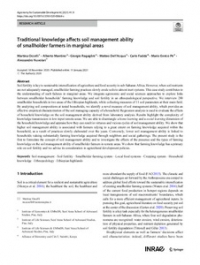Originally published on the IFPRI Blog
The launch of the United Nations Decade of Ecosystem Restoration (2021-2030) will direct a lot of attention to the biophysical sciences. A new special issue of the journal Ecological Restoration highlights the need for more focus on human considerations: Equity, inclusion, and justice. The issue— guest-edited by Ruth Meinzen-Dick of IFPRI, Marlène Elias of the Alliance of Bioversity International and the International Center for Tropical Agriculture, and Deepa Joshi of the International Water Management Institute–poses the question: Ecological restoration, by whom and for whom?
The Earth's ecological resilience is inextricably linked to the well-being of its people. Thus, social inclusion must be at the heart of the ecological restoration agenda, not on the periphery or as an add-on. For researchers, policymakers, and non-governmental organizations, this means striving for balance between the biophysical and social sciences, breaking down siloes between fields of science, and pursuing interdisciplinary research.
The COVID-19 pandemic energized the One Health approach, which focuses on interconnections between human health, animal health, and ecosystem health to prevent zoonotic disease outbreaks. Efforts to address the climate crisis need a similar interdisciplinary focus, or else projects to restore ecosystems will end up deepening existing power imbalances in the communities and societies that depend on them.
But how do we go about centering equity and inclusion in ecological restoration? The 11 papers in the special issue shed light on this question, with perspectives from academics and practitioners, NGOs, and government actors working across disciplines. The overarching guidance is to focus research and attention on three pillars: Power relations, historical awareness, and scale integration.
Power relations
Power relations between various actors—research institutions and communities, governments and local communities, community members and households—mediate struggles over natural resources and control over labor. They also determine what is counted as legitimate knowledge, which has enormous implications for ecological restoration processes. Scientists and policymakers often dismiss or ignore locally-produced environmental knowledge, which leads to failures and inefficiencies in restoration projects. The promotion of a singular, universal knowledge base about nature closes the door to potential solutions and approaches that come out of a plurality of local or indigenous knowledges about ecosystems.
In addition, access to and control over land is extremely gendered, and power imbalances in this sphere dictate how land can be used for restoration purposes. When land gains economic value as it is transformed from "wasted" to "regenerated," women (and other marginalized groups) lacking secure tenure can be evicted or dispossessed as that land is claimed by those with more power.
Historical awareness
Many restoration efforts begin with mapping lands potentially suitable for projects like tree plantings, but often the history of how such lands are used, contested, or governed by local people goes unexamined. Categorizing land as "marginalized", "wasted" or "barren" based only on biophysical markers can hide the ways that people use it, especially if they do not have formal land titles. Assuming that lands without lush vegetation are "degraded" from some romanticized past can lead to narratives of local people as "forest destroyers," pitting environmentalists against the very communities that could be their most effective partners. These narratives assume that local people destroy ecosystems when in fact, in some cases, their practices sustain or enhance them.
The absence of historical awareness can also play a role in the commodification of nature. Preserved or restored lands are sometimes turned into recreational sites that charge entry fees—privileging the values of tourists over the values of local people who use that land for agriculture, fishing, pasture, or forest livelihoods. Ahistorical understandings of landscapes can lead to ecological restoration efforts that exclude local populations, or even criminalize their livelihoods.
Scale integration
Scale integration means considering how policies and practices at all scales affect the realities of natural resource users, their environmental management decisions, and their livelihoods. Environmental agendas such as the International Principles and Standards for the Practice of Ecological Restoration created by the Society for Ecological Restoration often focus on large-scale actions at the regional or watershed level scales. However, top-down policies and interventions at large scales can prevent democratic engagement in natural resource governance and can be non-inclusive.
The larger the scale of policies and programs, the more actors will be involved and affected. This means there will be trade-offs among many different goals and priorities (e.g., those between the creation of protected areas with entry fees and efforts to support the livelihoods of local people depending on such land as a commons). Understanding these tradeoffs at all scales—individual, household, community, country, region, etc.—is key to avoiding the exploitation and further marginalization of vulnerable populations, especially rural women.
Measuring the success of ecological restoration projects using principally biophysical standards will lead to an incomplete understanding of these trade-offs, and a deepening of inequalities. For example, we should be skeptical of measuring success in reforestation efforts by the number of fast-growing commercial tree species being seeded into landscapes with a complex history of political and economic dispossession of local communities. That might be restoration—but by whom and for whom?
For more perspectives on how to center inclusion, equity and justice in ecological restoration agendas, please read the special issue ofEcological Restoration and view a session on restoration in the June Global Landscapes Forum. In addition, please stay tuned for a publication on the 10 People-Centered Rules for Socially Sustainable Restoration from the authors of this special issue.
---
Thrive blog is a space for independent thought and aims to stimulate discussion among sustainable agriculture researchers and the public. Blogs are facilitated by the CGIAR Research Program on Water, Land and Ecosystems (WLE) but reflect the opinions and information of the authors only and not necessarily those of WLE and its donors or partners.
WLE and partners are supported by CGIAR Trust Fund Contributors, including: ACIAR, DGIS, FCDO, SDC, Sida and others.












